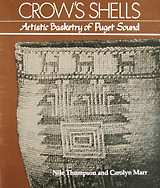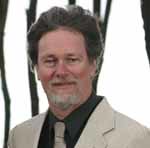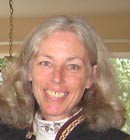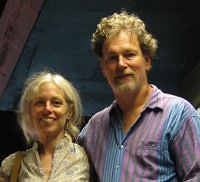Seattle, WA 98107
206-784-6665
Name and Logo
The name of Dushuyay Research stems from the Twana Indians of western Washington’s Hood Canal region. In the Twana language, dushuyay
means ‘wolf.’ It is pronounced with Romance language vowels (the first
two syllables rhyming with English ‘shoe’ and the last syllable with
‘fly‘). The wolf is an important guardian spirit in Twana culture and
can function as either a war power or a hunting power.
The following is a description of the wolf design in Twana basketry and comes from Thompson and Marr’s 1983 book, Crow’s Shells: Artistic Basketry of Puget Sound.

WOLF
The “wolf” design is based on the “dog,” having the same head, neck, body and legs as the straight-legged “dog.” The “dog” has an upturned tail while the “wolf” has a downward slanting tail. With the decline of the timber wolf in the area and the appearance and importance of the horse, the “wolf” was reinterpreted as “horse” by some Twana after 1890. Due to the slant of the tail, the “wolf” faces toward the right in order to match the direction of the pitch.
Unlike the “dog,” the “wolf” appears only rarely on coiled works. On soft twined baskets “wolves” are usually found in the role of rum designs; occasionally they are seen on the main design field. Variations include different body, head, tail and leg lengths, attempts to slant the legs, a narrowing of the head width, and a tail which goes up vertically before slanting downward.
For a listing of the 100 library locations with a copy of Crow's Shells, visit http://www.worldcatlibraries.org/oclc/9575582&tab=holdings&loc=USA#tabs
Partners
Dr. Nile Thompson and Carolyn Marr own and operate Dushuyay Research. Thompson and Marr have a combined total of over 70 years of experience working with American Indian museums, organizations and tribes in Washington, British Columbia, Montana, Idaho and Oregon.They are recognized experts in many areas concerning these groups, including language, culture, basketry, history, geography, photography, education and oral literature. However, the breadth of their experience and knowledge goes beyond working with Indian tribes and encompasses the broader history and cultures of the region. The partners provide services either independently or as a team.
To view Thompson's profile, scroll down.
To view Marr's profile, click here.
To view a list of joint publications, click here.

Biography:
A native of Washington State, Nile Thompson is a linguist and anthropologist. Since 1973 he has been involved in recording and preserving the American Indian languages and knowledge of traditional cultures of the Pacific Northwest and Western Canada. He has long-time affiliations with the Skokomish Tribe of Hood Canal and the Steilacoom Tribe of southern Puget Sound. He has taught at a number of colleges in the area.
Dr. Thompson is also a well-respected historian, having written both corporate and school histories. He has also worked in museums (directing, exhibit design, interpretative text writing, public programming, curation and fundraising). He was also a co-founder and past president of the Swedish Finn Historical Society. He has over forty publications to his credit in addition to numerous research reports.
In his free time, he coaches high school soccer.
Education:
University of Washington
Ph.D. in Linguistics, 1985
Dissertation: Twana baby talk and its theoretical implications
M.A. in Linguistics, 1979
Thesis: Predicate raising in Twana
B.A. in General Studies, 1972
Major: Anthropology-Linguistics-Ethnomusicology-Psychology
Thesis: The interaction of phonological rules in Blackfoot
Selected Publications:
- 2010
- Nicholas Delin and the choice of Commencement Bay (with C. Dale Sloat). Nordic Heritage Museum Historical Journal 6(1):48-61.
- 2007
- An atlas of indigenous Seattle (with Coll Thrush). In Native Seattle: Histories from the Crossing-Over Place by Thrush, pp. 209-55. Seattle: University of Washington Press.
- 2006
- Unlikely bedfellows: How worldview and pedagogy can hinder language preservation (with Sloat). MIT Working Papers on Endangered and Less Familiar Languages 7:1-16, Studies in Salishan.
- 2005
- The case of the two ladies and the owl: How a disagreement can help a dying language speak (with Sloat). University of British Columbia Working Papers in Linguistics 16:234-44.
- View the abstract at http://fnlg.arts.ubc.ca/40ICSNLabstracts/NileRThompson.htm
- The case of the two ladies and the owl: How a disagreement can help a dying language speak (with Sloat). University of British Columbia Working Papers in Linguistics 16:234-44.
- Review of Coming to Shore: Northwest Coast Ethnology, Traditions, and Visions by Marie Mauzé, Michael E. Harkin, and Sergei Kan (eds.). Lincoln: University of Nebraska Press. American Indian Culture and Research Journal 29(2):126-29.
- Review of Tending the Wild: Native American Knowledge and the Management of California’s Natural Resources by M. Kat Anderson (with Sloat). Berkeley: University of California Press. American Indian Culture and Research Journal 29(4).
- 2004
- Proto-Salishan *y in Coastal Salishan languages (with Sloat). Studies in Salish Linguistics in Honor of M. Dale Kinkade, Donna B. Gerdts and Lisa Matthewson, eds. University of Montana Occasional Papers in Linguistics 17:377-409.
- Building for Learning: Seattle Public School Histories, 1862-2000 (with Marr). Seattle: Seattle Public Schools.
- The growth of Salishan ‘gardens’: Part One: Interior Salish (with Sloat). University of British Columbia Working Papers in Linguistics 14:385-402.
- The use of oral literature to provide community health education on the Southern Northwest Coast (with Sloat). American Indian Culture and Research Journal 28(3):1-28).
- 2002
- The First One Hundred Years: A History of PSF Industries and PSF Mechanical. Seattle: PSF Industries and PSF Mechanical.
- 2000
- An initial look at Twana applicatives. University of British Columbia Working Papers in Linguistics 3(127-32).
- 1999
- Some comments on Stubbs (1997) (with James Armagost). International Journal of American Indian Linguistics 65(1):121-25.
- 1994
- Skokomish. Native America in the Twentieth Century: An Encyclopedia, Davis (ed.), pp. 600-01. New York: Garland Publishing.
- Steilacoom. Native America in the Twentieth Century: An Encyclopedia, Davis (ed.), pp. 617-18. New York: Garland Publishing.
- Review of The Structure of Twana Culture by William Elmendorf. American Indian Quarterly 18(3):415-16.
- Review of Where the People Gather: Carving a Totem Pole by Vickie Jensen. American Indian Culture and Research Journal 17(4):175-78.
- Southern Coast Salish oral literature and health education (with Sloat). Papers for the 29th International Conference on Salish and Neighboring Languages, pp. 313-20. Pablo, MT: Salish Kootenai College.
- 1993
- An analysis of diachronic denasalization in Twana. American Indian Linguistics and Ethnography in Honor of Laurence C. Thompson by Mattina and Montler (eds.). University of Montana Occasional Papers in Linguistics 10:303-16.
- 1992
- An odyssey to the discovery of nursery tales in Twana. On the Translation of Native American Literatures by B. Swann (ed.), pp. 176-90. Washington, DC: Smithsonian Institute Press.
- Review of Ravensong: A Natural and Fabulous History of Ravens and Crows by Catherine Feher-Elston. American Indian Culture and Research Journal 16(4):252-53.
- 1991
- The legacy of introduced disease: The southern Coast Salish (with George Guilmet, Robert Boyd and David Whited). American Indian Culture and Research Journal 15(4):1-33.
- Opening the Pacific slope: The 1824 McMillan expedition. Cowlitz Historical Quarterly 33(1):1-44.
- Salmon Bay Charlie: Last headman of the Lake People. Columbia Magazine (Washington State Historical Society) 5(2):34-37.
- 1990
- Review of Faces of a Reservation: Portrait of the Warm Springs Indian Reservation by Cynthia Stowell. American Indian Quarterly 14(1):109-10.
- Review of The Takelma and Their Athapaskan Neighbors by Dennis J. Gray. American Indian Quarterly 14(3):322-23.
- Steilacoom Tribe of Indians (with Dan Marshall). A Time of Gathering: An Intertribal Welcome -- Statements from Thirty-six Washington Tribes, Haines & Wright (eds.). Seattle, WA: Thomas Burke Memorial State Museum.
- 1989
- On the need for ethnographic information in Native American dictionary construction. Preprints from the 23rd International Conference on Salish and Neighboring Languages. Steilacoom Tribal Museum.
- 1988
- The original residents of Shilshole Bay. Passport to Ballard: The Centennial Story by Kay Reinartz (ed.), pp. 10-16. Seattle: Ballard Historical Society & Ballard News Tribune.
- A Brief Look at the Steilacoom Indians. Federal Acknowledgment Process: Hearings Before the Senate Select Committee on Indian Affairs, United States Senate, One Hundredth Congress, 2nd Session. Washington, DC: US Government Printing Office.
- Review of Coast Salish Essays by Wayne Suttles. American Indian Culture and Research Journal 2(1):73-76.
- Grayhead, leader of the Steilacoom Indians. The Steilacoom Gazette, No. 1.
- 1987
- Neighbors don’t use titles: The Steilacoom tribe and the Hudson’s Bay Company. Occurrences (Historic Fort Nisqually) 7(2):4-5.
- Review of Transition and Change on the Northwest Coast: The Makah, Nuu-Chah-Nulth, Kwakiutl and Nuxatl by Ruth Kirk. Pacific Northwest Quarterly 78(1-2):66.
- Washington tribal museums struggle for survival. Signature 4(4):4-5.
- 1986
- Lost Perspectives: The Art and Culture of Western Washington Indians (with Darrel Thiel). Tacoma: Washington State Historical Society.
- 1984
- Ed Carriere: A Suquamish tradition continues. American Indian Basketry Magazine 4(15):20-25.
- Lexical representation of Salish verb roots (with Douglas Isaacson). Amerindian Linguistics III. Kansas Working Papers in Linguistics 9(2):31-46. University of Kansas.
- Female indicators in the Twana language. Working Papers of the Linguistics Circle 4(2):331-36. Department of Linguistics, University of Victoria.
- 1983
- Crow’s Shells: Artistic Basketry of Puget Sound (with Marr). Seattle: Dushuyay Publications.
- 1982
- Twana Games (with Marr). Seattle: Daybreak Star Press.
- 1981
- Suquamish basketry (with Marr). American Indian Basketry Magazine 1(4):28-31.
- A contribution to Puget Salish lexical studies. Occasional Papers in Linguistics 2(80- 83). Department of Anthropology, University of Montana.
- 1980
- Twined basketry of the Twana, Chehalis and Quinault (with Marr and Janda Volkmer). American Indian Basketry Magazine 1(3):12-19.
- 1979
- Twana Dictionary: Student Version. Shelton, WA: Twana Language Project, Skokomish Indian Tribe.
- Predicate raising in Twana. Working Papers in Linguistics 5(54-61). Department of Linguistics, University of Washington.

Biography:
Carolyn J. Marr is the librarian at the Museum of History and Industry in Seattle, Washington. She is an anthropologist and is well known in the Pacific Northwest as an authority on local history, Native American culture, and historic photographs. She has worked with the Chehalis, Suquamish, Tulalip and Makah Tribes on projects relating to photographs and oral history as well as material culture, especially basketry and textiles. Several exhibits have resulted from her work, including one on the boarding school experience in western Washington. Her publications include Portrait in Time: Photographs of the Makah by Samuel G. Morse, 1897-1903, and numerous articles in Pacific Northwest Quarterly, Columbia Magazine, American Indian Art Magazine and other journals.
Education:
University of Denver
M.A. in Anthropology, 1979
Museum Studies Program
Thesis: A History of Salish Weaving: The Effects of Culture Change on a Textile Tradition
University of Washington
M.A. in Library Sciences, 1978
Stanford University
B.A. in Anthropology, 1971
Phi Beta Kappa, magna cum laude
Selected Publications:
- 2008
- Objects of function and beauty: Basketry of the Southern Coast Salish. S'abadeb -- The Gifts: Pacific Coast Salish Art and Artists by Barbara Brotherton (ed.), pp. 198-225. Seattle: Seattle Art Museum.
- 2004
- Building for Learning: Seattle Public School Histories, 1862-2000 (with Thompson). Seattle: Seattle Public Schools.
- 1999
- Assimilation through education: Indian boarding schools in the Pacific Northwest for American Memory. Client: Library of Congress.
- Read the essay at http://content.lib.washington.edu/aipnw/marr.html
- Assimilation through education: Indian boarding schools in the Pacific Northwest for American Memory. Client: Library of Congress.
- 1998
- Review of Witch of Kodakery: The Photography of Myra Albert Wiggins, 1869-1956, by Carole Glauber. Pacific Northwest Quarterly 90(1):42-43.
- 1996
- Marking oneself: Use of photographs by Native Americans of the Southern Northwest Coast. American Indian Culture and Research Journal 20(3):51-64.
- 1994
- Anders Beer Wilse: Photographer of the Pacific Northwest and Norway. Columbia Magazine 8(2):24-29.
- 1991
- Basketry regions of Washington State. American Indian Art Magazine 16(2):40-49.
- 1990
- Continuity and change in the basketry of western Washington. In The Art of Native American Basketry: A Living Legacy, pp. 267-80. New York: Greenwood Press.
- Photographers and their subjects on the Southern Northwest Coast: Motivations and responses. Arctic Anthropology 27(2):13-26.
- 1989
- Taken pictures: On interpreting Native American photographs of the southern Northwest Coast. Pacific Northwest Quarterly 80(2):52-61.
- 1988
- Samuel G. Morse: Clallam County’s talented turn-of-the-century photographer of the Makah. Columbia Magazine 2(1):31-35, 50.
- Wrapped twined baskets of the southern Northwest Coast: A new art form with an ancient past. American Indian Art Magazine 13(3):54-63.
- 1987
- Portrait in Time: Photographs of the Makah by Samuel G. Morse, 1896-1903. Neah Bay, WA: Makah Cultural & Research Center.
- 1984
- Salish baskets from the Wilkes Expedition. American Indian Art Magazine 9(3):44-51.
- 1983
- Washington coastal Indian villages, 1907: The photographs of Albert Henry Barnes. Pacific Northwest Quarterly 74(3):106-113.
- Crow’s Shells: Artistic Basketry of Puget Sound (with Thompson). Seattle: Dushuyay Publications.
- 1982
- Native Americans of the Pacific Northwest: A Photographic Record. Seattle: University of Washington Libraries.
- Twana Games (with Thompson). Seattle: Daybreak Star Press.
- 1981
- Sea Monster House. Seattle: Pacific Science Center.
- Suquamish basketry (with Thompson). American Indian Basketry Magazine 1(4):28-31.
- 1980
- The Chehalis People (with Donna Hicks and Kay Francis). Oakville, WA: Confederated Tribes of the Chehalis Reservation.
- Twined basketry of the Twana, Chehalis and Quinault (with Thompson and Janda Volkmer). American Indian Basketry Magazine 1(3):12-19.
- 1979
- Qwayailk stories: Five tales from the Upper Chehalis (with Hicks and Francis). Oakville: Confederated Tribes of the Chehalis Reservation.
- 1978
- Salish weaving in British Columbia. Northwest Arts, 4(22):1, 6.
- The original Northwest art: Alex Williams, Lena Dunston: and A guide to Indian art [in Seattle]. Argus Magazine—Openings, (September):30-35, 38-39.
- West African Textiles, African Arts 11(4):81.

- 2004
- Building for Learning: Seattle Public School Histories, 1862-2000. Seattle: Seattle Public Schools.
- 1983-1984
- Artistic basketry of Puget Sound. Lectures presented at The Burke Museum, Oregon Historical Society, Washington State Historical Society and Washington State Capitol Museum.
- 1983
- Crow’s Shells: Artistic Basketry of Puget Sound. Dushuyay Publications. (Distributed by University of Washington Press.)
- 1982
- Twana Games. Seattle: Daybreak Star Press.
- 1981
- Suquamish basketry. American Indian Basketry Magazine 1(4):28-31.
- Baskets of the Twana. Lecture presented at the Seattle Art Museum’s symposium entitled, Native American Basketry of Western North America: An Overview.
- 1980
- Twined basketry of the Twana, Chehalis and Quinault (with Janda Volkmer). American Indian Basketry Magazine 1(3):12-19.
